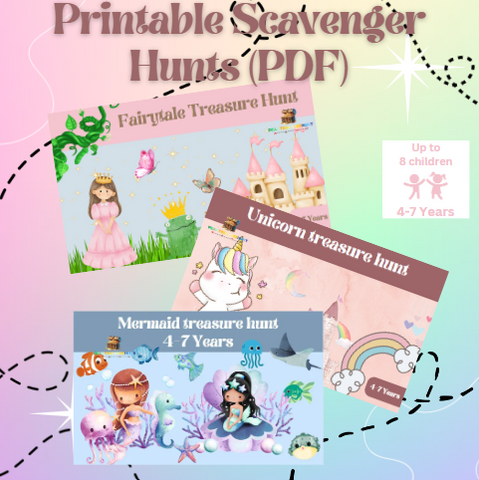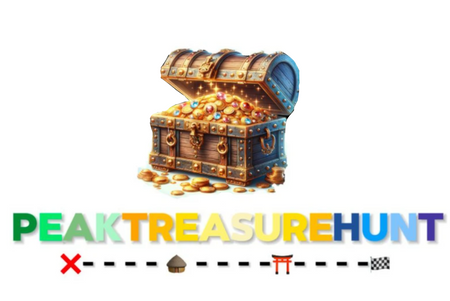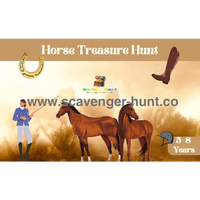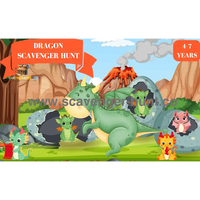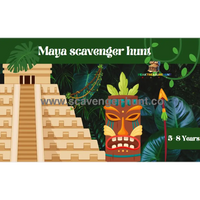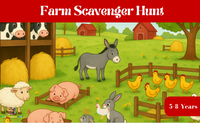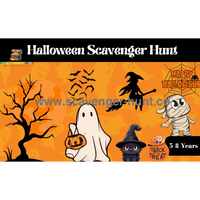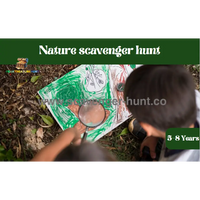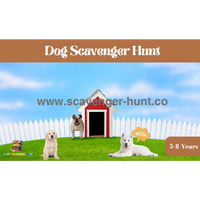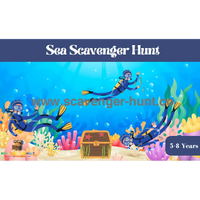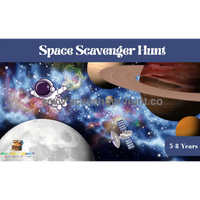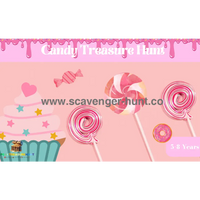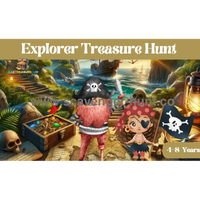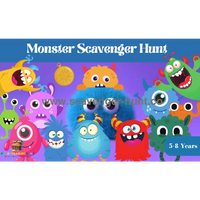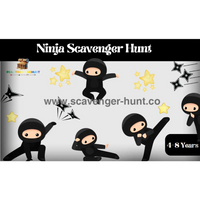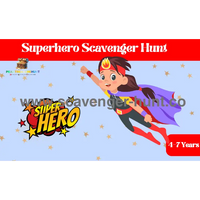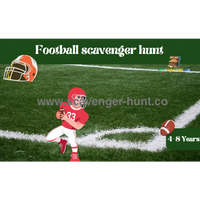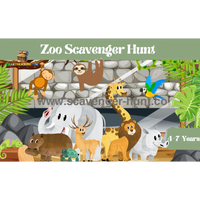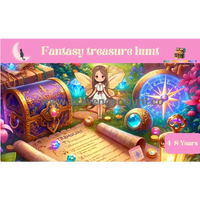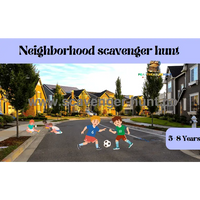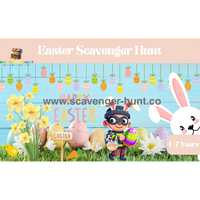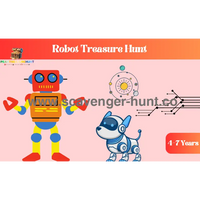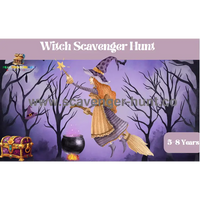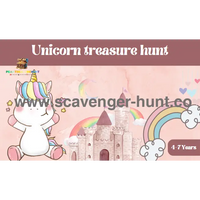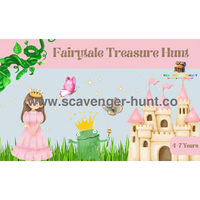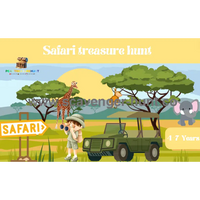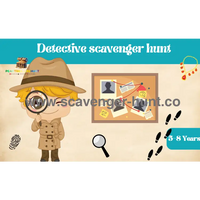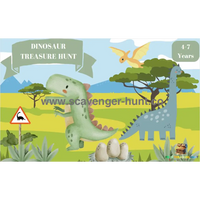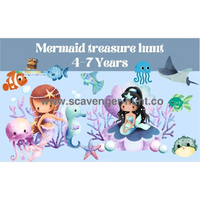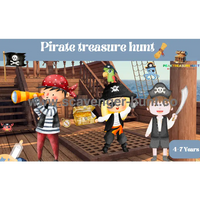🐸🐼🦒40 Exciting Animal Would You Rather Questions: Interactive Cards for Kids
Introduction
Engaging children in imaginative play and critical thinking can be a delightful adventure, especially when it involves the fascinating world of animals. Our specially curated list of "Animal Would You Rather Questions" offers a unique journey into the animal kingdom, tailored for kids aged 4 to 12. These 40 interactive cards are designed not only to entertain but also to educate and inspire young minds about wildlife, conservation, and the environment. By choosing between whimsical scenarios involving various animals, children will develop their reasoning skills, empathy for living creatures, and a deeper appreciation for nature's diversity.
The Basics of Scavenger Hunts for Young Explorers
Understanding Scavenger Hunts
A scavenger hunt is an engaging game that challenges participants to find a series of items or complete tasks from a list. For young explorers, particularly those in kindergarten, these hunts are designed to be simple yet stimulating. The objective is to find objects or achieve simple tasks based on clues or a straightforward list. This activity is perfect for kindergarteners as it aligns with their developmental stage by focusing on basic problem-solving, observation, and the joy of discovery.
Scavenger hunts for young kids often involve:
- Identifying colors, shapes, or textures in nature or around the house.
- Finding objects that start with specific letters of the alphabet.
- Completing fun tasks like drawing a picture of a tree or hugging their favorite teddy bear.
These activities are not only a source of entertainment but also a tool for learning and development. They encourage curiosity, enhance observational skills, and promote physical activity, all while children explore their environment in a playful manner.
A scavenger hunt is a dynamic and engaging game that challenges players to find items or complete tasks listed on a scavenger hunt list. Tailored specifically for young children, especially kindergarteners, these hunts are designed to be straightforward yet captivating. The goal is for participants to discover objects or accomplish simple tasks based on either direct clues or a simple list, making it an ideal activity for kids in this age group. Scavenger hunts cater to kindergarteners' developmental needs by emphasizing basic problem-solving, keen observation, and the intrinsic excitement of discovery.
Key Features of Scavenger Hunts for Kindergarteners:
Scavenger hunts for young explorers are meticulously crafted to include activities that are both fun and educational. These activities often involve:
-
Identifying Different Elements: Children are encouraged to recognize and find colors, shapes, or textures, whether in nature during outdoor hunts or around the house for indoor activities. This helps in developing their ability to notice details and categorize objects based on their characteristics.
-
Alphabetical Adventures: Finding objects that start with specific letters of the alphabet not only makes the hunt exciting but also reinforces their letter recognition skills and expands their vocabulary.
-
Engaging Tasks: Completing engaging tasks, such as drawing a picture of something they see (like a tree) or expressing affection towards a favorite object (like hugging their teddy bear), adds variety to the hunt. These tasks stimulate creativity and emotional expression while ensuring the activity remains interactive and lively.
Educational Benefits:
Scavenger hunts are more than just games; they are powerful learning tools that blend entertainment with education. Participating in these activities offers numerous developmental benefits, including:
-
Stimulating Curiosity: By encouraging children to explore and discover, scavenger hunts ignite a sense of wonder and curiosity about the world around them.
-
Enhancing Observational Skills: These hunts sharpen observational skills as children learn to pay attention to details and differentiate between various objects and their properties.
-
Promoting Physical Activity: As an active game, scavenger hunts encourage physical movement, whether children are searching indoors or exploring the great outdoors.
-
Encouraging Exploratory Learning: Children learn best through play, and scavenger hunts provide a structured yet flexible approach to learning that adapts to each child's pace and interests.
-
Fostering Social Skills: When conducted in groups, scavenger hunts help children learn to work collaboratively, share discoveries, and support each other’s learning process.
Scavenger hunts represent a perfect blend of fun, learning, and adventure for kindergarteners. By engaging in this activity, young children not only enjoy themselves but also build foundational skills that will benefit them throughout their educational journey. These hunts are a testament to the power of learning through play, offering an enriching experience that nurtures curiosity, enhances observation, and promotes a healthy, active lifestyle. Whether at home, in school, or out in nature, scavenger hunts are a versatile and rewarding activity that can be tailored to suit any theme or learning objective, making every hunt a unique adventure in discovery.

Benefits for Kindergarteners
Participating in scavenger hunts offers numerous benefits for kindergarteners, including:
-
Cognitive Development: Enhances problem-solving skills and memory through the process of seeking and finding.
-
Physical Activity: Encourages children to move around, improving their motor skills and overall health.
-
Social Skills: When done in groups, it fosters teamwork, communication, and social interaction.
-
Nature Connection: Outdoor scavenger hunts help children develop a love and appreciation for the environment and wildlife.
Scavenger hunts are not just games; they are powerful learning tools that offer a myriad of benefits to kindergarteners. These benefits span cognitive, physical, social, and environmental domains, making scavenger hunts an enriching activity for young children. Here, we delve into how these adventures contribute to a child's development.
Cognitive Development
One of the most significant benefits of scavenger hunts is their impact on a child's cognitive growth. As kids engage in the search for items or completion of tasks, they're doing much more than just playing. They are:
-
Enhancing Problem-solving Skills: Each step of the hunt requires kids to think critically and make decisions. Whether it's figuring out a clue or determining where to look for an item, these activities challenge their brains and sharpen their problem-solving abilities.
-
Boosting Memory: Remembering the items on the list, recalling where they've already searched, and keeping track of what they've found all contribute to enhancing memory. It's a fun and engaging way to exercise their brains and improve memory recall.
Physical Activity
Scavenger hunts get kids moving. Unlike many activities that involve sitting in front of a screen, scavenger hunts encourage children to:
-
Walk, Run, and Explore: As they move from one location to another, looking for items or fulfilling tasks, they're engaging in healthy physical activity. This not only improves their motor skills but also contributes to their overall health and well-being.
-
Develop Fine Motor Skills: Picking up small items or performing tasks that require a delicate touch helps refine their fine motor skills, enhancing their ability to control and coordinate their movements.
Social Skills
When participating in group scavenger hunts, kindergarteners have the opportunity to:
-
Work as a Team: Collaborating with peers to find items or solve clues teaches valuable lessons in teamwork. It encourages them to listen to others, share ideas, and work together towards a common goal.
-
Improve Communication: Discussing strategies, asking for help, and expressing ideas are all part of the scavenger hunt experience. These interactions bolster their communication skills, helping them convey their thoughts and understand others more effectively.
-
Foster Friendships: Participating in a shared activity like a scavenger hunt can help kindergarteners build and strengthen friendships. The shared excitement and achievements create bonds and memories that can last a lifetime.
Nature Connection
Especially for outdoor scavenger hunts, there's an invaluable benefit of connecting with nature. These hunts:
-
Encourage Appreciation for the Environment: Searching for natural items or observing wildlife prompts children to notice and appreciate the beauty and diversity of the world around them.
-
Teach Environmental Stewardship: Through engagement with the outdoors, children learn about the importance of caring for the environment. It's an excellent way to instill values of conservation and respect for nature from an early age.
Scavenger Hunts offer kindergarteners a comprehensive developmental experience. They're not only fun and exciting but also deeply educational, covering a broad spectrum of developmental areas. By participating in scavenger hunts, kids can enhance their cognitive abilities, enjoy physical exercise, develop social skills, and foster a love for the environment. It's a multi-faceted activity that enriches the lives of young learners in profound ways.

Organizing a Scavenger Hunt
To create a successful scavenger hunt for young explorers:
-
Choose a Theme: Base it on the children’s interests, seasons, holidays, or educational topics like animals or colors.
-
Prepare the List: The list should be age-appropriate, with visual aids or simple words that kindergarteners can understand.
-
Set the Boundaries: Clearly define the play area to ensure it's safe and manageable for the children to explore.
-
Provide Tools: Give them bags or baskets for collecting items and maybe a magnifying glass for added fun.
-
Celebrate All Efforts: Make sure every child feels celebrated for their participation, not just the completion of the list.
Crafting a scavenger hunt that captivates and educates young children requires thoughtful preparation and creativity. By focusing on their developmental stage, interests, and safety, you can create an experience that's both fun and enriching. Here's a step-by-step guide to organizing a successful scavenger hunt for kindergarteners.
Choose a Theme
The first step in creating a scavenger hunt is selecting a theme. A well-chosen theme can spark children's interest and make the hunt more engaging. Consider:
-
Children's Interests: Base the theme on what the children are currently fascinated by, be it dinosaurs, fairy tales, or space exploration.
-
Seasons and Holidays: Use the time of year to inspire your theme, such as a springtime nature hunt or a Halloween-themed search.
-
Educational Topics: Incorporate learning into the fun by choosing themes like animals, colors, shapes, or numbers.
Prepare the List
The heart of the scavenger hunt is the list of items to find or tasks to complete. When preparing this list for kindergarteners:
-
Use Visual Aids: Include pictures or simple drawings next to each item on the list to make it accessible for children who are still learning to read.
-
Keep it Age-Appropriate: Ensure the items or tasks are achievable for their age group, avoiding anything too complex or beyond their physical capabilities.
-
Incorporate Learning: Turn the hunt into a learning opportunity by including items that teach them about the theme, encouraging observation and inquiry.
Set the Boundaries
Safety is paramount, especially with young kids. Establishing clear boundaries is essential:
-
Define the Play Area: Choose a safe, enclosed area for the hunt, such as a backyard, a park section, or a classroom. Make sure it's free from hazards and manageable for kindergarteners to navigate.
-
Communicate the Limits: Before starting, explain the boundaries to the children, ensuring they understand where they can and cannot go.
Provide Tools
Enhance the scavenger hunt experience by equipping the kids with tools:
-
Collection Bags or Baskets: Give each child something in which to collect their items, making sure it's lightweight and easy to carry.
-
Magnifying Glass: For added fun and a bit of detective work, provide a magnifying glass. It's great for examining items closely and can spark discussions about what they find.
Celebrate All Efforts
A scavenger hunt is about the journey, not just the destination. It's important that every child feels recognized and celebrated:
-
Acknowledge Participation: Ensure each child is praised for their effort and participation, regardless of how many items they find.
-
Offer Rewards: Consider giving out small rewards or certificates to all participants. This can help reinforce their sense of achievement and encourage positive feelings about the activity.
-
Reflect on the Experience: After the hunt, take some time to discuss what they found, what they learned, and what they enjoyed the most. This reflection can deepen their learning and appreciation for the experience.
Organizing a scavenger hunt for kids is a wonderful way to combine fun with educational opportunities. By choosing an engaging theme, preparing an age-appropriate list, ensuring safety, providing the right tools, and celebrating every effort, you create not just a game, but a memorable learning experience that kids will cherish.

Tips for a Fun Experience
- Keep it short and sweet to match young children’s attention spans.
- Use pictures or symbols for non-readers.
- Incorporate sensory activities (e.g., find something soft, something that makes noise).
- Ensure the safety of the environment where the hunt takes place.
- Debrief with the children afterward, discussing what they found and what they learned.
Scavenger hunts are a versatile, dynamic way to engage young children in learning through play. By incorporating elements of the natural world, these activities can lay the groundwork for a lifelong appreciation of the environment and wildlife, making every find a step towards greater curiosity and knowledge.
Scavenger hunts can transform the ordinary into the extraordinary for kids, turning every search into an adventure filled with discovery and learning. To ensure a fun, engaging, and educational experience, here are some tips tailored specifically for organizing scavenger hunts for kids.
Keep It Short and Sweet
Kids have limited attention spans, so it's important to design scavenger hunts that are concise and engaging. Consider the following:
-
Duration: Aim for the hunt to last no longer than 15-30 minutes. This timeframe keeps the activity exciting without overwhelming them.
-
List Length: Keep the list of items or tasks short. Five to ten items are usually plenty for young children, ensuring they remain interested from start to finish.
Use Pictures or Symbols
For pre-readers or early readers, visuals are key:
-
Visual Clues: Accompany each item on the list with a picture or symbol. This makes it accessible for non-readers and adds an element of recognition and matching to the hunt.
-
Interactive Lists: Consider using laminated cards with visuals that children can check off with a dry-erase marker, adding an interactive component to the activity.
Incorporate Sensory Activities
Engaging the senses can make the scavenger hunt more memorable and enriching:
-
Diverse Textures: Include items that invite touch, such as something smooth, rough, or soft. This encourages tactile exploration.
-
Sounds: Ask them to find something that makes noise, enhancing auditory engagement. It could be a natural element, like leaves rustling, or a specific object, like a bell.
-
Scents: If appropriate, include items with distinct smells. This can be especially fun in a garden setting, where children can smell different plants or flowers.
Ensure Safety
The environment where the scavenger hunt takes place must be safe for young children:
-
Secure Area: Whether indoors or outdoors, ensure the area is free from hazards. This includes checking for anything that might pose a risk, from sharp objects to bodies of water.
-
Supervision: Always have adults or older children supervise the hunt to provide guidance, prevent wandering, and assist with any challenges that arise.
Debrief and Reflect
After the hunt, gather the kids for a discussion about their discoveries:
-
Share Finds: Encourage children to show and tell what they found. This not only validates their effort but also allows for shared learning.
-
Discuss Learnings: Ask what they learned during the hunt. This can range from facts about the items they found to experiences of working together or solving problems.
-
Celebrate Discoveries: Highlight the joy of discovery and the value of curiosity. This reinforces the positive feelings associated with exploration and learning.
Scavenger hunts are a dynamic and versatile way to engage young minds in learning through play. By keeping activities short and sweet, using visuals for non-readers, incorporating sensory experiences, ensuring safety, and debriefing afterward, you can create a rich, engaging experience. Such activities not only provide fun and education in the moment but also lay the groundwork for a lifelong appreciation of the natural world, encouraging curiosity and a deepening of knowledge with every find.

Summary
Our collection of "Animal Would You Rather Questions" and the guide to organizing scavenger hunts are more than just entertainment; they are gateways to learning, exploration, and understanding. These activities encourage children to think, question, and engage with the world in a meaningful way. By presenting these interactive cards and organizing scavenger hunts, parents and educators can provide invaluable opportunities for growth, development, and fun. Remember, each question answered and each item found is a step towards nurturing informed, thoughtful, and environmentally conscious individuals.
Our curated collection of "Animal Would You Rather Questions" alongside our comprehensive guide to orchestrating scavenger hunts transcends the realm of mere amusement. These tools are ingeniously designed to serve as conduits for learning, exploration, and a deeper comprehension of the world that surrounds us. Through engaging with these meticulously crafted interactive cards and participating in thoughtfully organized scavenger hunts, kids are invited into an immersive process of thinking, questioning, and meaningful engagement with their environment.
For parents and educators, these resources are not just activities but invaluable opportunities to foster growth, stimulate development, and infuse joy into the learning process. Each "Would You Rather" question prompts children to weigh options, consider alternatives, and make decisions, thereby sharpening their cognitive abilities and decision-making skills. Meanwhile, scavenger hunts offer a dynamic way to connect with nature, enhance physical activity, boost problem-solving skills, and cultivate social interactions among peers.
Furthermore, these activities are not only about the immediate joy and excitement they bring. They are foundational steps towards nurturing individuals who are informed, thoughtful, and possess a keen awareness of their environment. The skills and values instilled through these playful yet profound experiences contribute to raising environmentally conscious individuals who appreciate the richness of the world they inhabit.
In essence, our collection of "Animal Would You Rather Questions" and the scavenger hunt guide are more than just pastimes; they are significant building blocks in a child's journey towards becoming a well-rounded, curious, and responsible individual. As each question is pondered and every item is discovered, we move one step closer to nurturing the minds and spirits of the future stewards of our planet.

Frequently Asked Questions
-
What age group are animal would you rather questions suitable for?
- These questions are designed for kids aged between 4 and 12, with the content tailored to be engaging and appropriate for this wide age range.
-
How can animal would you rather questions benefit my child?
- They encourage critical thinking, decision-making, and verbal expression, while also expanding their knowledge and understanding of the animal kingdom.
-
Can these questions be used in educational settings?
- Absolutely! Teachers can use them as a fun, interactive tool to engage students in discussions about animals, habitats, and biological concepts in a way that's accessible and enjoyable.
-
Are scavenger hunts educational?
- Yes, scavenger hunts can be highly educational, promoting observational skills, problem-solving, and teamwork, all while kids learn about the items or themes involved in the hunt.
-
How do I make a scavenger hunt for kids?
- Start by choosing a theme, then create a list of items or tasks related to that theme. Make sure they are age-appropriate and safe for the children participating. You can also include clues or puzzles to make the hunt more challenging and engaging.
Discover our complete Would You Rather Questions collection.
Discover our Complete Scavenger Hunts Collection.






